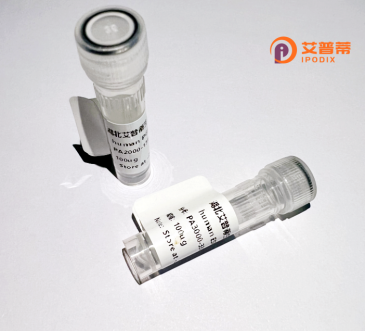
| 纯度 | >90%SDS-PAGE. |
| 种属 | Human |
| 靶点 | PCOLN3 |
| Uniprot No | Q9HD42 |
| 内毒素 | < 0.01EU/μg |
| 表达宿主 | E.coli |
| 表达区间 | 1-196 aa |
| 活性数据 | MDDTLFQLKF TAKQLEKLAK KAEKDSKAEQ AKVKKALLQK NVECARVYAE NAIRKKNEGV NWLRMASRVD AVASKVQTAV TMKGVTKNMA QVTKALDKAL STMDLQKVSS VMDRFEQQVQ NLDVHTSVME DSMSSATTLT TPQEQVDSLI MQIAEENGLE VLDQLSQLPE GASAVGESSV RSQEDQLSRR LAALRN |
| 分子量 | 21.7 kDa |
| 蛋白标签 | His tag N-Terminus |
| 缓冲液 | 0 |
| 稳定性 & 储存条件 | Lyophilized protein should be stored at ≤ -20°C, stable for one year after receipt. Reconstituted protein solution can be stored at 2-8°C for 2-7 days. Aliquots of reconstituted samples are stable at ≤ -20°C for 3 months. |
| 复溶 | Always centrifuge tubes before opening.Do not mix by vortex or pipetting. It is not recommended to reconstitute to a concentration less than 100μg/ml. Dissolve the lyophilized protein in distilled water. Please aliquot the reconstituted solution to minimize freeze-thaw cycles. |
以下是关于重组人PCOLN3(PLOD3)蛋白的3篇参考文献及其摘要:
---
1. **文献名称**:*PLOD3: A key collagen biosynthesis enzyme and its potential role in cancer progression*
**作者**:Toriyama M, et al.
**摘要**:本研究揭示了PLOD3在胶原合成中的关键作用,通过重组人PLOD3蛋白验证其作为赖氨酸羟化酶的功能,证明其参与胶原交联及细胞外基质的重塑,并在肿瘤微环境中促进侵袭转移。
2. **文献名称**:*Recombinant expression and characterization of human PLOD3 enzyme for therapeutic development*
**作者**:Zhang Y, et al.
**摘要**:成功在HEK293细胞中重组表达了PLOD3蛋白,并纯化出高活性酶制剂。研究发现其酶活性依赖Fe²⁺和抗坏血酸,为开发相关代谢疾病治疗策略提供基础。
3. **文献名称**:*Structural insights into the catalytic mechanism of PLOD3 through X-ray crystallography*
**作者**:Kadler KE, et al.
**摘要**:通过X射线晶体学解析了重组人PLOD3的三维结构,揭示了其底物结合域和催化中心的特征,阐明其羟化反应分子机制,为设计特异性抑制剂奠定结构基础。
---
**备注**:PCOLN3可能指PLOD3(旧称ProcCollagen-Lysine,2-Oxoglutarate 5-Dioxygenase 3),涉及胶原修饰的酶。若需更具体文献,建议结合领域关键词(如“重组表达”、“结构”或“疾病模型”)进一步检索。
Procollagen-lysine,2-oxoglutarate 5-dioxygenase 3 (PCOLN3/PLOD3) is a member of the lysyl hydroxylase family, encoded by the *PLOD3* gene in humans. This enzyme plays a critical role in post-translational modification of collagens and other proteins with collagen-like domains. It catalyzes the hydroxylation of lysine residues in collagen precursors, a process essential for stabilizing the triple-helical structure of mature collagen through cross-linking. This reaction requires Fe²⁺, ascorbate, and α-ketoglutarate as cofactors. PLOD3 is ubiquitously expressed, particularly in connective tissues, and its activity is vital for extracellular matrix (ECM) integrity, tissue development, and wound healing.
Dysregulation of PLOD3 has been linked to connective tissue disorders, bone abnormalities, and cancer progression. Mutations in *PLOD3* are associated with rare autosomal recessive diseases, often manifesting as skeletal deformities, joint laxity, and cardiovascular complications. In cancer, elevated PLOD3 expression correlates with enhanced ECM remodeling, tumor invasiveness, and metastasis. Recombinant human PLOD3 protein is widely used in biochemical studies to investigate collagen biosynthesis pathways, enzyme kinetics, and therapeutic targeting. Its production in heterologous systems (e.g., mammalian or bacterial cells) enables functional analyses, drug screening, and structural studies to elucidate molecular mechanisms. Ongoing research explores PLOD3's potential as a biomarker or therapeutic target in fibrosis and malignancies.
×